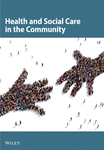Meeting personal hygiene needs in the community: a district nursing perspective on the health and social care divide
Abstract
The difference between health and social care is almost impossible to define, not least because ‘health’ is socially defined; and people with ‘social’ needs inevitably have some medical or health related problem. The two are intricately, perhaps irretrievably, intertwined. In spite of this, there has been a requirement to arrive at definitions of health and social care, which has been driven by NHS reforms embodied in the NHS and Community Care Act (Department of Health 1990). The national picture for the provision of health and social care is an inconsistent one, with some authorities jointly commissioning services, others jointly assessing clients for services, and the remainder where collaboration between the two services is either embryonic, or simply not happening. The health and social services have experienced immense upheaval in recent years, which is likely to continue for the foreseeable future. Against this backdrop, the following paper presents an important consequence of the community care reforms, which is the re-definition of certain aspects of district nursing work as ‘social care’, focusing particularly on the elusive ‘social bath’. The data presented in this paper comprise part of a larger, ethnographic study of district nursing work in which 37 district nursing sisters were interviewed in depth, following 13 days of participant observation of 130 home visits. Illustrative extracts from the data are presented and interpreted, and the likely professional implications of the findings are discussed.




